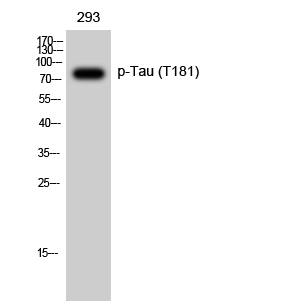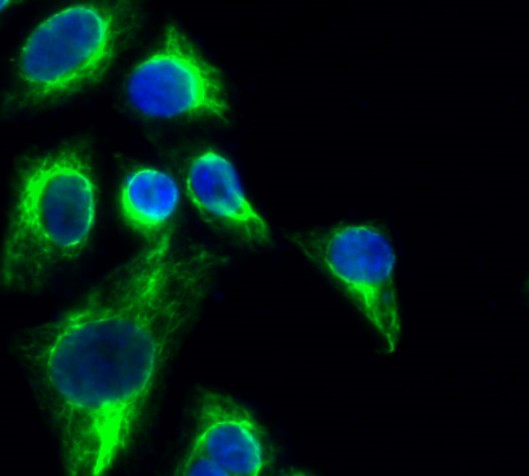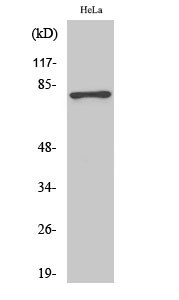Total Tau Cell-Based Colorimetric ELISA Kit
- 货号:KA3185C
- 应用:ELISA
- 种属:Human
- 其他名称:
- Microtubule-associated protein tau (Neurofibrillary tangle protein) (Paired helical filament-tau) (PHF-tau)
- 背景:
- alternative products:Additional isoforms seem to exist. Isoforms differ from each other by the presence or absence of up to 5 of the 15 exons. One of these optional exons contains the additional tau/MAP repeat,developmental stage:Four-repeat (type II) tau is expressed in an adult-specific manner and is not found in fetal brain, whereas three-repeat (type I) tau is found in both adult and fetal brain.,disease:Defects in MAPT are a cause of corticobasal degeneration (CBD). It is marked by extrapyramidal signs and apraxia and can be associated with memory loss. Neuropathologic features may overlap Alzheimer disease, progressive supranuclear palsy, and Parkinson disease.,disease:Defects in MAPT are a cause of frontotemporal dementia and parkinsonism linked to chromosome 17 (FTDP17) [MIM:600274, 172700]; also called frontotemporal dementia (FTD) or historically termed Pick complex. This form of frontotemporal dementia is characterized by presenile dementia with behavioral changes, deterioration of cognitive capacities and loss of memory. In some cases, parkinsonian symptoms are prominent. Neuropathological changes include frontotemporal atrophy often associated with atrophy of the basal ganglia, substantia nigra, amygdala. In most cases, protein tau deposits are found in glial cells and/or neurons.,disease:Defects in MAPT are a cause of pallido-ponto-nigral degeneration (PPND) [MIM:168610]. The clinical features include ocular motility abnormalities, dystonia and urinary incontinence, besides progressive parkinsonism and dementia.,disease:Defects in MAPT are a cause of progressive supranuclear palsy (PSP) [MIM:601104, 260540]; also known as Steele-Richardson-Olszewski syndrome. PSP is characterized by akinetic-rigid syndrome, supranuclear gaze palsy, pyramidal tract dysfunction, pseudobulbar signs and cognitive capacities deterioration. Neurofibrillary tangles and gliosis but no amyloid plaques are found in diseased brains. Most cases appear to be sporadic, with a significant association with a common haplotype including the MAPT gene and the flanking regions. Familial cases show an autosomal dominant pattern of transmission with incomplete penetrance; genetic analysis of a few cases showed the occurrence of tau mutations, including a deletion of Asn-613.,disease:Defects in MAPT may be a cause of hereditary dysphasic disinhibition dementia (HDDD) [MIM:607485]. HDDD is a frontotemporal dementia characterized by progressive cognitive deficits with memory loss and personality changes, severe dysphasic disturbances leading to mutism, and hyperphagia.,disease:In Alzheimer disease, the neuronal cytoskeleton in the brain is progressively disrupted and replaced by tangles of paired helical filaments (PHF) and straight filaments, mainly composed of hyperphosphorylated forms of TAU (PHF-TAU or AD P-TAU).,domain:The tau/MAP repeat binds to tubulin. Type I isoforms contain 3 repeats while type II isoforms contain 4 repeats.,function:Promotes microtubule assembly and stability, and might be involved in the establishment and maintenance of neuronal polarity. The C-terminus binds axonal microtubules while the N-terminus binds neural plasma membrane components, suggesting that tau functions as a linker protein between both. Axonal polarity is predetermined by tau localization (in the neuronal cell) in the domain of the cell body defined by the centrosome. The short isoforms allow plasticity of the cytoskeleton whereas the longer isoforms may preferentially play a role in its stabilization.,online information:Tau mutations,online information:Tau protein entry,online information:Vita minima - Issue 68 of March 2006,PTM:Glycation of PHF-tau, but not normal brain tau. Glycation is a non-enzymatic post-translational modification that involves a covalent linkage between a sugar and an amino group of a protein molecule forming ketoamine. Subsequent oxidation, fragmentation and/or cross-linking of ketoamine leads to the production of advanced glycation endproducts (AGES). Glycation may play a role in stabilizing PHF aggregation leading to tangle formation in AD.,PTM:Phosphorylation at serine and threonine residues in S-P or T-P motifs by proline-directed protein kinases (PDPK: CDC2, CDK5, GSK-3, MAPK) (only 2-3 sites per protein in interphase, seven-fold increase in mitosis, and in PHF-tau), and at serine residues in K-X-G-S motifs by MAP/microtubule affinity-regulating kinase (MARK) in Alzheimer diseased brains. Phosphorylation decreases with age. Phosphorylation within tau's repeat domain or in flanking regions seems to reduce tau's interaction with, respectively, microtubules or plasma membrane components. Phosphorylation on Ser-610, Ser-622, Ser-641 and Ser-673 in several isoforms during mitosis.,PTM:Polyubiquitinated. Requires functional TRAF6 and may provoke SQSTM1-dependent degradation by the proteasome (By similarity). PHF-tau can be modified by three different forms of polyubiquitination. 'Lys-48'-linked polyubiquitination is the major form, 'Lys-6'-linked and 'Lys-11'-linked polyubiquitination also occur.,similarity:Contains 4 Tau/MAP repeats.,subcellular location:Mostly found in the axons of neurons, in the cytosol and in association with plasma membrane components.,subunit:Interacts with PSMC2 through SQSTM1 (By similarity). Interacts with SQSTM1 when polyubiquitinated.,tissue specificity:Expressed in neurons. Isoform PNS-tau is expressed in the peripheral nervous system while the others are expressed in the central nervous system.,
- 功能:
- microtubule cytoskeleton organization, regulation of cell growth, cytoskeleton organization, microtubule-based process, negative regulation of microtubule depolymerization, regulation of cell size, positive regulation of organelle organization, negative regulation of organelle organization, positive regulation of cell development, regulation of cell morphogenesis involved in differentiation, regulation of neuron projection development, regulation of cell morphogenesis, positive regulation of cell growth, regulation of axon extension, regulation of microtubule polymerization or depolymerization, negative regulation of microtubule polymerization or depolymerization, positive regulation of microtubule polymerization or depolymerization, regulation of microtubule polymerization, regulation of microtubule depolymerization, positive regulation of microtubule polymerization, positive regulation
- 细胞定位:
- Cytoplasm, cytosol . Cell membrane ; Peripheral membrane protein ; Cytoplasmic side . Cytoplasm, cytoskeleton . Cell projection, axon . Cell projection, dendrite . Secreted . Mostly found in the axons of neurons, in the cytosol and in association with plasma membrane components (PubMed:10747907). Can be secreted; the secretion is dependent on protein unfolding and facilitated by the cargo receptor TMED10; it results in protein translocation from the cytoplasm into the ERGIC (endoplasmic reticulum-Golgi intermediate compartment) followed by vesicle entry and secretion (PubMed:32272059). .
- 组织表达:
- Expressed in neurons. Isoform PNS-tau is expressed in the peripheral nervous system while the others are expressed in the central nervous system.



